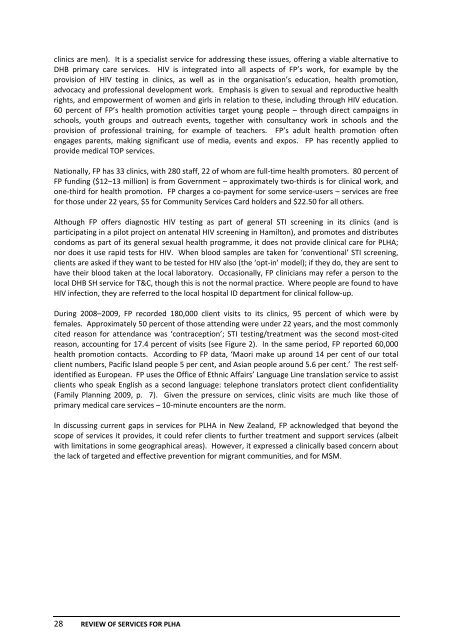Review of services for people living with HIV in New Zealand
Review of services for people living with HIV in New Zealand
Review of services for people living with HIV in New Zealand
- No tags were found...
Create successful ePaper yourself
Turn your PDF publications into a flip-book with our unique Google optimized e-Paper software.
cl<strong>in</strong>ics are men). It is a specialist service <strong>for</strong> address<strong>in</strong>g these issues, <strong>of</strong>fer<strong>in</strong>g a viable alternative toDHB primary care <strong>services</strong>. <strong>HIV</strong> is <strong>in</strong>tegrated <strong>in</strong>to all aspects <strong>of</strong> FP’s work, <strong>for</strong> example by theprovision <strong>of</strong> <strong>HIV</strong> test<strong>in</strong>g <strong>in</strong> cl<strong>in</strong>ics, as well as <strong>in</strong> the organisation’s education, health promotion,advocacy and pr<strong>of</strong>essional development work. Emphasis is given to sexual and reproductive healthrights, and empowerment <strong>of</strong> women and girls <strong>in</strong> relation to these, <strong>in</strong>clud<strong>in</strong>g through <strong>HIV</strong> education.60 percent <strong>of</strong> FP’s health promotion activities target young <strong>people</strong> – through direct campaigns <strong>in</strong>schools, youth groups and outreach events, together <strong>with</strong> consultancy work <strong>in</strong> schools and theprovision <strong>of</strong> pr<strong>of</strong>essional tra<strong>in</strong><strong>in</strong>g, <strong>for</strong> example <strong>of</strong> teachers. FP’s adult health promotion <strong>of</strong>tenengages parents, mak<strong>in</strong>g significant use <strong>of</strong> media, events and expos. FP has recently applied toprovide medical TOP <strong>services</strong>.Nationally, FP has 33 cl<strong>in</strong>ics, <strong>with</strong> 280 staff, 22 <strong>of</strong> whom are full‐time health promoters. 80 percent <strong>of</strong>FP fund<strong>in</strong>g ($12–13 million) is from Government – approximately two‐thirds is <strong>for</strong> cl<strong>in</strong>ical work, andone‐third <strong>for</strong> health promotion. FP charges a co‐payment <strong>for</strong> some service‐users – <strong>services</strong> are free<strong>for</strong> those under 22 years, $5 <strong>for</strong> Community Services Card holders and $22.50 <strong>for</strong> all others.Although FP <strong>of</strong>fers diagnostic <strong>HIV</strong> test<strong>in</strong>g as part <strong>of</strong> general STI screen<strong>in</strong>g <strong>in</strong> its cl<strong>in</strong>ics (and isparticipat<strong>in</strong>g <strong>in</strong> a pilot project on antenatal <strong>HIV</strong> screen<strong>in</strong>g <strong>in</strong> Hamilton), and promotes and distributescondoms as part <strong>of</strong> its general sexual health programme, it does not provide cl<strong>in</strong>ical care <strong>for</strong> PLHA;nor does it use rapid tests <strong>for</strong> <strong>HIV</strong>. When blood samples are taken <strong>for</strong> ‘conventional’ STI screen<strong>in</strong>g,clients are asked if they want to be tested <strong>for</strong> <strong>HIV</strong> also (the ‘opt‐<strong>in</strong>’ model); if they do, they are sent tohave their blood taken at the local laboratory. Occasionally, FP cl<strong>in</strong>icians may refer a person to thelocal DHB SH service <strong>for</strong> T&C, though this is not the normal practice. Where <strong>people</strong> are found to have<strong>HIV</strong> <strong>in</strong>fection, they are referred to the local hospital ID department <strong>for</strong> cl<strong>in</strong>ical follow‐up.Dur<strong>in</strong>g 2008–2009, FP recorded 180,000 client visits to its cl<strong>in</strong>ics, 95 percent <strong>of</strong> which were byfemales. Approximately 50 percent <strong>of</strong> those attend<strong>in</strong>g were under 22 years, and the most commonlycited reason <strong>for</strong> attendance was ‘contraception’; STI test<strong>in</strong>g/treatment was the second most‐citedreason, account<strong>in</strong>g <strong>for</strong> 17.4 percent <strong>of</strong> visits (see Figure 2). In the same period, FP reported 60,000health promotion contacts. Accord<strong>in</strong>g to FP data, ‘Maori make up around 14 per cent <strong>of</strong> our totalclient numbers, Pacific Island <strong>people</strong> 5 per cent, and Asian <strong>people</strong> around 5.6 per cent.’ The rest selfidentifiedas European. FP uses the Office <strong>of</strong> Ethnic Affairs’ Language L<strong>in</strong>e translation service to assistclients who speak English as a second language: telephone translators protect client confidentiality(Family Plann<strong>in</strong>g 2009, p. 7). Given the pressure on <strong>services</strong>, cl<strong>in</strong>ic visits are much like those <strong>of</strong>primary medical care <strong>services</strong> – 10‐m<strong>in</strong>ute encounters are the norm.In discuss<strong>in</strong>g current gaps <strong>in</strong> <strong>services</strong> <strong>for</strong> PLHA <strong>in</strong> <strong>New</strong> <strong>Zealand</strong>, FP acknowledged that beyond thescope <strong>of</strong> <strong>services</strong> it provides, it could refer clients to further treatment and support <strong>services</strong> (albeit<strong>with</strong> limitations <strong>in</strong> some geographical areas). However, it expressed a cl<strong>in</strong>ically based concern aboutthe lack <strong>of</strong> targeted and effective prevention <strong>for</strong> migrant communities, and <strong>for</strong> MSM.28 REVIEW OF SERVICES FOR PLHA
















